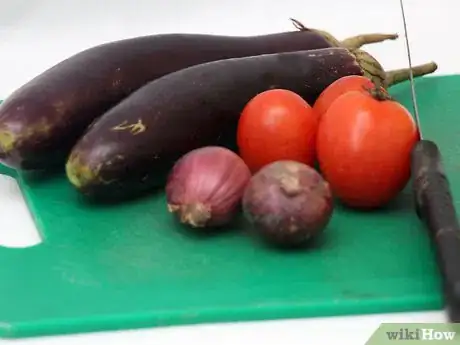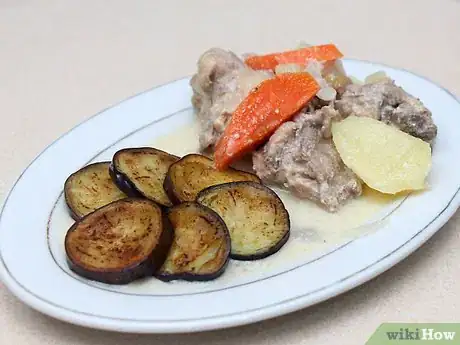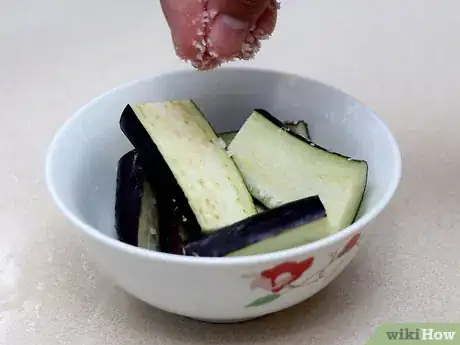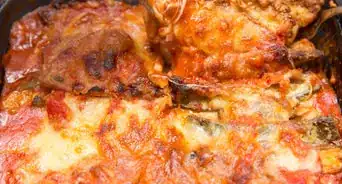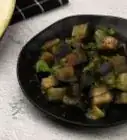X
wikiHow is a “wiki,” similar to Wikipedia, which means that many of our articles are co-written by multiple authors. To create this article, 9 people, some anonymous, worked to edit and improve it over time.
This article has been viewed 23,024 times.
Learn more...
Eggplant, also known as aubergine, is used for many tasty dishes. It is especially used in Mediterranean, Middle Eastern, and Eastern cooking, where the strong flavor and texture of eggplant is nicely meshed with strong spices and plenty of olive oil. When buying an eggplant, it's important to know what to look for.
Steps
Part 2
Part 2 of 4:
Picking Good Eggplants
-
1Choose firm and plump eggplants. If there is any softness, this indicates that the flesh is already starting to go off.
- Softness in some spots can be salvaged by cutting around those areas but since it reduces the amount of flesh you'll end up with, ensure that you get them for a total bargain if they're like this.
-
2Look for eggplants that are shiny or glossy and smooth. There should be no rough or brown patches anywhere on the fruit. If bruised or scarred, do not buy.
-
3Look for the distinctive cleft at the wider end of the eggplant.
-
4Check the cap. This is also known as the calyx. This should be sitting tightly, looking fresh and mold-free.
Advertisement
Part 3
Part 3 of 4:
Using Eggplants
-
1Cook eggplant. Eggplants are bland and inedible raw. Their virtue lies in their ability to absorb other flavors, distribute the flavors through a dish and offer a meat-like texture that makes the dish substantial. In Middle Eastern, Mediterranean and Indian cooking, they are often accompanied by tomatoes, onion and varied spices.
-
2Match eggplants to the flavors they go best with. Eggplants are best enjoyed when they marry well with the foods they're being cooked with. Eggplants are a great match for the following:
- Dairy: Cheesy or creamy dishes; sour cream
- Herbs: Basil, coriander/cilantro, garlic, mint, parsley (pesto on eggplant is especially tasty)
- Spices: Coriander/cilantro, cumin, ginger
- Oils: Olive oil (lots of it!)
- Other: Tomatoes
- Meat: Lamb, beef, mince.
-
3Find eggplant recipes. Some great ones include:
- Baked eggplant
- Fried eggplant
- Grilled eggplant
- Stuffed eggplant.
Advertisement
Part 4
Part 4 of 4:
Preparing Eggplants
-
1Use young, fresh eggplants without peeling or degorging. Degorging is the process of salting and draining the eggplant, which is needed in older and bigger fruits due to their bitterness and also reduces the amount of oil absorbed by the eggplant flesh. The eggplant can also be blanched, if needed; follow the instructions of your recipe.
-
2Salt or degorge the eggplant. This is used for larger and older eggplants and to reduce the uptake of too much oil during cooking. (Note: The eggplant will still absorb plenty of oil, just not as much as without the salting.)
- Clean the eggplant.
- Cut it into slices. The thickness should reflect the end use in the recipe.
- Note that for roasting, you're more likely to use halves instead and cut cross-hatches across each half. The rest of the method here still applies.
- Line the slices inside a colander.
- Sprinkle with salt. Be generous, most will be washed off.
- Put a plate onto the slices. The weight helps to squash out excess liquid in the slices.
- Set aside for half an hour.
- Rinse well under cold running water.
- Dab or pat dry with paper towels.
Advertisement
Community Q&A
-
QuestionWhen I cut into an eggplant, is it supposed to have darker seeds?
 Community AnswerYes, it is.
Community AnswerYes, it is. -
QuestionWhat if the eggplant is brown inside?
 Community AnswerIt may be spoiled.
Community AnswerIt may be spoiled. -
QuestionCan I fry my large slices of eggplant, which I use as lasagna sheets, a couple days before I construct the beef lasagna?
 MicheleTop AnswererI wouldn’t. Frying anything and then letting it sit only results in a soggy mess. It’s always best to prepare eggplant fresh as you’re making your eggplant lasagna.
MicheleTop AnswererI wouldn’t. Frying anything and then letting it sit only results in a soggy mess. It’s always best to prepare eggplant fresh as you’re making your eggplant lasagna.
Advertisement
References
- ↑ Good Housekeeping, Complete Cook's Book, 2000, ISBN 0-00-710074-4
- Good Housekeeping, Complete Cook's Book, 2000, ISBN 0-00-710074-4 – research source
About This Article
Advertisement




